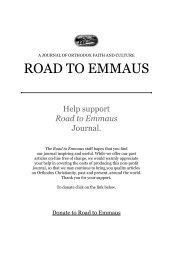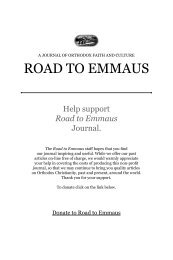RTE No 20 Interior - Road to Emmaus Journal
RTE No 20 Interior - Road to Emmaus Journal
RTE No 20 Interior - Road to Emmaus Journal
Create successful ePaper yourself
Turn your PDF publications into a flip-book with our unique Google optimized e-Paper software.
<strong>Road</strong> <strong>to</strong> <strong>Emmaus</strong> Vol. X, <strong>No</strong>. 1 (#36)rte: We tend <strong>to</strong> think of centers of early Romano-British Christianity as beingnear such places as York. When the Romans pulled out in the fifth century,did Wales also have a fully-established hierarchical church?fr. deiniol: Of course. They say that Bangor-in-Arfon in <strong>No</strong>rth West Waleswas a diocese in the sense that we use the word now, as a terri<strong>to</strong>rial area fromthe sixth century. Bede talks about a monastery in Bangor-on-Dee (anotherBangor) with 2,000 monks. Certainly, there were Celtic bishops as well.Of course, we can’t speak about “The Celtic Church,” as if it was an organizedentity that incorporated what we now call Brittany, Scotland, Wales,and Ireland in<strong>to</strong> an identifiable independent body. It was part of the worldwideChurch. It was catholic – but not in the contemporary sense of “RomanCatholic” – in faith and doctrine. There was coming and going, andthere was much interest on the Continent about what was happening in Britain.Many writers speak of early Christianity here, and early Fathers of theChurch mention it as well – Origen, Lactantius, Tertullian, Eusebius.They knew of the Christian Church in Britain, and monks used <strong>to</strong> travel<strong>to</strong> the East from the Celtic-speaking lands on pilgrimage. There was evangelizationalong the trade routes, and our monks certainly went <strong>to</strong> see monasticlife in Egypt, the Holy Land, Rome, and Constantinople. Monasticismhere seemed <strong>to</strong> resemble more the Lavra system than the classical coenobiticmonasteries that evolved in the West. There is also a tradition that the Celticbishops St. David, St. Teilo, and St. Padarn were all consecrated by the patriarchof Jerusalem. According <strong>to</strong> tradition, one was given a sakkos, thebishop’s vestment, another, a portable altar, and the third, a bishop’s staff.So there were connections with the East, but we don’t have <strong>to</strong> show a connectionwith the East <strong>to</strong> prove that this church of the Celts was catholic andorthodox in faith and doctrine. Yes, they had their local cus<strong>to</strong>ms, such asshaving their head in a certain way for the monastic <strong>to</strong>nsure, as we find localcus<strong>to</strong>ms <strong>to</strong>day in various local Orthodox churches. And, as within Orthodoxy<strong>to</strong>day, they had different calendars. After the Synod of Whitby, when theChurch of the Celtic peoples adapted its local cus<strong>to</strong>ms <strong>to</strong> conform <strong>to</strong> those ofRome, it came under Canterbury and thereby under Rome. So when the GreatSchism came about, it was part of the patriarchate of the West, and went withthe western Churches. Canterbury remained the primatial see of Britain.rte: How did the 11th-century <strong>No</strong>rman invasion affect Christian Wales?Pho<strong>to</strong>: St. David of Wales, St. David’s Cathedral.<strong>20</strong>










